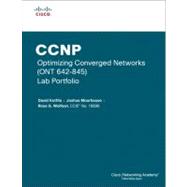
| Introduction | p. xiv |
| Describing Campus Network Requirements | p. 1 |
| Optimizing Converged Networks Lab Configuration Guide | p. 1 |
| Quality of Service Scenarios | p. 2 |
| Wireless Scenarios | p. 5 |
| Cisco VoIP Implementations | p. 7 |
| Configure CME Using the CLI and Cisco IP Communicator (2.6.1) | p. 7 |
| Scenario | p. 7 |
| Configure Addressing | p. 7 |
| Configure Router Telephony Service | p. 9 |
| Create Directory Numbers | p. 10 |
| Create Phones | p. 11 |
| Install Cisco IP Communicator | p. 12 |
| Run Cisco IP Communicator | p. 16 |
| Establish a Call from Host A to Host B | p. 19 |
| Change the Codec Being Used | p. 21 |
| Introduction to IP QoS | p. 25 |
| Preparing for QoS (3.6.1) | p. 25 |
| Overview | p. 26 |
| Preliminaries | p. 27 |
| Create Basic Pagent IOS and TGN Configurations | p. 27 |
| Store Basic Pagent Configurations | p. 33 |
| Create Advanced Pagent IOS, TGN, and NQR Configurations | p. 34 |
| Store Advanced Pagent Configurations | p. 38 |
| Display Traffic Statistics | p. 38 |
| Basic Pagent Configurations | p. 40 |
| IOS Configuration on R4: Stored in flash: basic-ios.cfg | p. 40 |
| TGN Configuration on R4: Stored in flash: basic-tgn.cfg | p. 41 |
| IOS Configuration on ALS1: Stored in flash: basic.cfg | p. 41 |
| Pagent Configurations | p. 42 |
| IOS Configuration on R4 (TrafGen): Stored in flash: advanced-ios.cfg | p. 42 |
| TGN Configuration on R4 (TrafGen): Stored in flash: advanced-tgn.cfg | p. 43 |
| IOS Configuration on ALS1: Stored in flash: advanced.cfg | p. 43 |
| NETLAB-Compatible Advanced Pagent Configurations | p. 44 |
| IOS Configuration on R4: Stored in flash: advanced-ios.cfg | p. 44 |
| TGN Configuration on R4: Stored in flash: advanced-tgn.cfg | p. 45 |
| IOS Configuration on ALS1: Stored in flash: advanced.cfg | p. 45 |
| NQR Configuration | p. 46 |
| Sample Advanced Pagent Configuration | p. 46 |
| R1 | p. 47 |
| R2 | p. 47 |
| R3 | p. 47 |
| R4 | p. 48 |
| R4 NQR | p. 48 |
| Installing SDM (3.6.2) | p. 49 |
| Scenario | p. 49 |
| Lab Preparation | p. 49 |
| Prepare the Router for SDM | p. 49 |
| Configure Addressing | p. 50 |
| Extract SDM on the Host | p. 52 |
| Install SDM on the PC | p. 55 |
| Run SDM from the PC | p. 59 |
| Install SDM to the Router | p. 61 |
| Run SDM from the Router | p. 66 |
| Monitor an Interface in SDM | p. 68 |
| Configuring QoS with SDM (3.6.3) | p. 69 |
| Scenario | p. 69 |
| Preparation | p. 69 |
| Configure Physical Interfaces | p. 70 |
| Configure Routing with EIGRP | p. 71 |
| Connect to R1 Using SDM | p. 71 |
| Use the SDM QoS Wizard | p. 72 |
| Verify QoS Operation with SDM | p. 77 |
| DiffServ QoS Model | p. 79 |
| Default Queuing Tools (4.11.1) | p. 79 |
| Scenario | p. 79 |
| Preparation | p. 79 |
| Configure Addressing | p. 80 |
| Configure EIGRP AS 1 | p. 83 |
| Contrast Interface Queuing Strategies | p. 85 |
| Verify and Change Queuing Modes | p. 87 |
| Modify Default Queuing Settings | p. 93 |
| Intermediate Queuing Tools (4.11.2) | p. 95 |
| Scenario | p. 95 |
| Preparation | p. 95 |
| Configure the Physical Interfaces | p. 96 |
| Configure EIGRP AS 1 | p. 97 |
| Configure Custom Queuing | p. 98 |
| Configure Priority Queuing | p. 104 |
| Challenge | p. 107 |
| TCP Header Compression (4.11.3) | p. 108 |
| Scenario | p. 108 |
| Configure Addressing | p. 108 |
| Enable Telnet Access on R2 | p. 108 |
| Enable TCP Header Compression | p. 108 |
| Verify TCP Header Compression | p. 109 |
| Comparing Queuing Strategies (4.11.4) | p. 111 |
| Scenario | p. 111 |
| Preparation | p. 111 |
| Configure Addressing and Routing | p. 112 |
| Create NQR Configuration for Testing Purposes | p. 113 |
| Table of Contents provided by Publisher. All Rights Reserved. |
The New copy of this book will include any supplemental materials advertised. Please check the title of the book to determine if it should include any access cards, study guides, lab manuals, CDs, etc.
The Used, Rental and eBook copies of this book are not guaranteed to include any supplemental materials. Typically, only the book itself is included. This is true even if the title states it includes any access cards, study guides, lab manuals, CDs, etc.